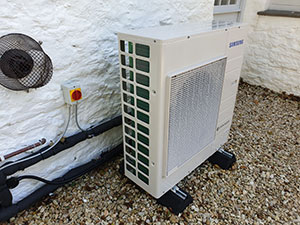When it comes to housing provision, social landlords have some tough decisions to make; how to transition their housing stock so it is fit for a net-zero world, while continuing to deliver social value for their tenants.
For heating homes, the aim is to make heating low carbon and affordable without compromising comfort. The challenge, however, is how to achieve low carbon heating without incurring costs that could inadvertently tip tenants into fuel poverty.
The introduction of the Future Homes Standard in 2025 mandates the use of low carbon heating for all new-build homes in England. Similar rules are also proposed for Scottish and Welsh homes by their respective governments. However, there are over four million existing social homes in the UK that also need to move away from fossil fuels if we are to achieve our net-zero ambitions. How we electrify the UK’s domestic heating is one of the country’s most challenging problems.
All-electric heat pumps offer a low-carbon technology solution to replace traditional boilers, but the cost to retrofit the UK’s four million social homes is estimated by Capital Economics to be almost £35bn. With most homes expected to undergo two or three boiler replacements before 2050, the UK needs a transition plan that avoids leaving RSLs with stranded heating assets and guards against saddling them with unaffordable capital costs.
Today, capital costs for low carbon heat technologies are subsidised through a government scheme called the renewable heat incentive (RHI). This scheme, however, will end in March 2021 and, as yet, the government has not announced if – or how – it will replace the subsidy. Savvy landlords are looking to make changes to their heating systems while incentives are still available.
A pathway to decarbonisation
Adopting a hybrid heating approach offers an effective pathway to achieving low carbon heating while helping to address concerns over costs and stranded assets. Hybrid heating systems operate an electric heat pump alongside the existing gas or oil boiler and offer significant benefits to both  RSLs and tenants.
RSLs and tenants.
The hybrid approach is typically easier and cheaper to retrofit than an all-electric heat pump. It does not require a change to the existing radiators and a smaller heat pump can also be fitted. It also opens up the opportunity for RSLs to benefit from future capacity market payments by using smart, integrated technology to dynamically switch between the use of electricity and gas. This reduces demands on the electricity grid at peak times and turns homes into ‘peaking plant’ able to reduce the amount of electricity in use when the grid is under stress. Flexibility to support the grid has the potential to bring financial benefit to RSLs so a hybrid, dual-fuel approach to low-carbon heating can lead to valuable additional income.
This approach helps to reduce bills for tenants and lower carbon emissions, but without compromising comfort levels in the home.
The increasing value of flexibility
Electrifying our domestic heating and transport systems will increase overall electricity demand. BEIS forecasts that we will require 80GW of new capacity by 2035, a substantial increase from the current capacity of around 100GW.
New capacity is increasingly met by renewables in the energy mix. This is good as renewables are low carbon, but they are also inherently inflexible; the availability of power is dictated by how much sun and wind there is, and other environmental conditions that do not necessarily match variations in demand. This makes balancing supply and demand more challenging. Increasingly, grid operators are looking to improve their control of demand rather than supply in order to balance the network.
To continue to allow new sources of renewable power on to the grid we need to increase the flexibility of the electricity system. Energy storage and demand management (such as demand side response – DSR) are important contributors to flexibility, which is why Britain’s electricity system operator, National Grid, currently offers financial incentives to businesses who actively manage their demand.
Hybrid heating systems using smart controls offer the opportunity to switch between the gas and electric supply. These systems can deliver flexible demand response and help to decarbonise domestic heating with no increase in peak load. By deploying this approach at scale using multiple properties, RSLs have the potential to benefit from the financial value inherent in residential demand response.
Hybrid heat and demand response
A typical scenario would see the heat pump warm the house using cheap electricity overnight ready for the morning. Come mid-afternoon, the smart controls call on the gas boiler to quickly increase heat in the property. During early evening, the smart control system can switch between the gas boiler and electric heat pump to avoid adding to peak electricity demands on an overloaded grid.
This shift of electricity use away from peak times and peak prices helps residents to reduce their energy bills and improves grid stability.
Hybrid heating systems can move as much demand to gas as they like – they have complete load flexibility. With a gas boiler always available, the system need never compromise the comfort of the occupants.
Smart control is key to success
A smart control panel, developed by PassivSystems, enables switching between the two heat sources to automatically use the most cost-effective heating mode at any time of the day or night.
The control unit uses machine learning technology to understand the thermal characteristics of the property and create a mathematical model of the house and heating system.
The smart control system combines the thermal model with weather data to choose exactly the right approach to keep the heat pump running gently while ramping up slowly throughout the night using a dynamically controlled flow temperature. This allows the house to cool slightly, reducing thermal losses, while keeping the heat pump running at a temperature that is as low as possible.
Machine learning enables the system to automatically tune the algorithm to the properties of the house. So, for example, the system would choose continuous heating for a slow responding system such as underfloor heating or turn off for some of the night if the house loses heat quickly. There are no further modifications or interventions required in tenants’ properties.
The strategy for controlling a hybrid heating system is to utilise the boiler to provide bursts of heat to warm the house up quickly, with the heat pump providing temperature maintenance and a ‘base load’ during periods where a fully warm house is not required.
Hybrid heating is proven technology, which is in use today. Unlocking the value of demand response capacity in  domestic homes, enabled by hybrid heating, would provide the means for RSLs to fund their transition to low carbon heat.
domestic homes, enabled by hybrid heating, would provide the means for RSLs to fund their transition to low carbon heat.
Capital Economics report:
https://www.ft.com/content/9cba0522-f564-11e9-b018-3ef8794b17c6#comments-anchor
Article from Ian Rose, Professional Services Director at PassivSystems
- Log in to post comments













